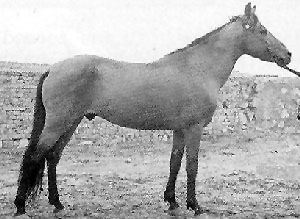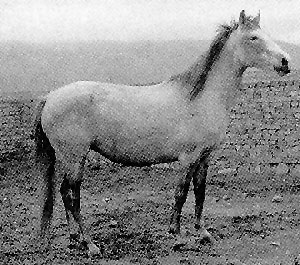Iomud Horses
 Also Known As: Iomudskaya (Russian), Yamud (Iran)
Also Known As: Iomudskaya (Russian), Yamud (Iran)
The Iomud breed originates from ancient Turkmenian horses. It was developed by the Iomud tribe in the Tashauz oasis in southern Turkmenia. As the breed occupied the margin of the Turkmenian breed area, it was influenced by steppe breeds. During the 14th century, it was influenced by Arabian stallions. In contrast to the Akhal-Teke, the Iomud breed is kept in herds in the desert and semi-desert.
The Iomud conformation has the following features: large clean-cut head, sometimes Roman-nosed, medium-long neck; medium-high withers, solid back with small curve to the withers, nicely turned and regularly sloping croup, shallow chest; clean fine legs, often bowed; sparse mane and tail; delicate skin. Color is gray or chestnut, rarely golden chestnut or black. The measurements (in cm) of stallions are: height at withers 152, oblique body length 151, chest girth 168, cannon bone girth 19; mares: 149, 150, 167 and 18.3 respectively.
 The Iomud is a long-lived healthy horse. It shows soft "floating" action. The purebred
population has declined substantially. Stud farms to preserve the Iomud genotype were
set up in Turkmenia in 1983. They are charged with protecting the breed and restoring
the breeding nucleus to a size of 240-250 mares from the present 140 mares. A conservation
farm is being established in the Kyzyl-Atrek district.
The Iomud is a long-lived healthy horse. It shows soft "floating" action. The purebred
population has declined substantially. Stud farms to preserve the Iomud genotype were
set up in Turkmenia in 1983. They are charged with protecting the breed and restoring
the breeding nucleus to a size of 240-250 mares from the present 140 mares. A conservation
farm is being established in the Kyzyl-Atrek district.
References
Dmitriez, N.G. and Ernst, L.K. (1989) Animal Genetic Resources of the USSR. Animal Production and Health Paper Publ. by FAO, Rome, 517 pp.
Mason, I.L. 1996. A World Dictionary of Livestock Breeds, Types and Varieties. Fourth Edition. C.A.B International. 273 pp.
